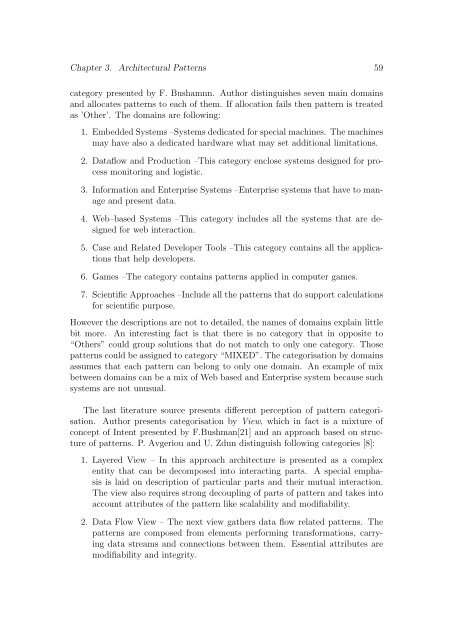Migration of a Chosen Architectural Pattern to Service Oriented ...
Migration of a Chosen Architectural Pattern to Service Oriented ...
Migration of a Chosen Architectural Pattern to Service Oriented ...
Create successful ePaper yourself
Turn your PDF publications into a flip-book with our unique Google optimized e-Paper software.
Chapter 3. <strong>Architectural</strong> <strong>Pattern</strong>s 59category presented by F. Bushamnn. Author distinguishes seven main domainsand allocates patterns <strong>to</strong> each <strong>of</strong> them. If allocation fails then pattern is treatedas ’Other’. The domains are following:1. Embedded Systems –Systems dedicated for special machines. The machinesmay have also a dedicated hardware what may set additional limitations.2. Dataflow and Production –This category enclose systems designed for processmoni<strong>to</strong>ring and logistic.3. Information and Enterprise Systems –Enterprise systems that have <strong>to</strong> manageand present data.4. Web–based Systems –This category includes all the systems that are designedfor web interaction.5. Case and Related Developer Tools –This category contains all the applicationsthat help developers.6. Games –The category contains patterns applied in computer games.7. Scientific Approaches –Include all the patterns that do support calculationsfor scientific purpose.However the descriptions are not <strong>to</strong> detailed, the names <strong>of</strong> domains explain littlebit more. An interesting fact is that there is no category that in opposite <strong>to</strong>“Others” could group solutions that do not match <strong>to</strong> only one category. Thosepatterns could be assigned <strong>to</strong> category “MIXED”. The categorisation by domainsassumes that each pattern can belong <strong>to</strong> only one domain. An example <strong>of</strong> mixbetween domains can be a mix <strong>of</strong> Web based and Enterprise system because suchsystems are not unusual.The last literature source presents different perception <strong>of</strong> pattern categorisation.Author presents categorisation by View, which in fact is a mixture <strong>of</strong>concept <strong>of</strong> Intent presented by F.Bushman[21] and an approach based on structure<strong>of</strong> patterns. P. Avgeriou and U. Zdun distinguish following categories [8]:1. Layered View – In this approach architecture is presented as a complexentity that can be decomposed in<strong>to</strong> interacting parts. A special emphasisis laid on description <strong>of</strong> particular parts and their mutual interaction.The view also requires strong decoupling <strong>of</strong> parts <strong>of</strong> pattern and takes in<strong>to</strong>account attributes <strong>of</strong> the pattern like scalability and modifiability.2. Data Flow View – The next view gathers data flow related patterns. Thepatterns are composed from elements performing transformations, carryingdata streams and connections between them. Essential attributes aremodifiability and integrity.
















